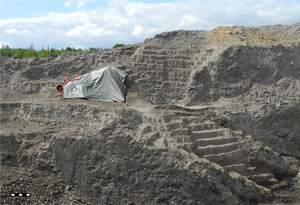Daria Carobene, M.Sc.
Palaeoecology of Miocene benthic marine macroinvertebrate communities of the whale-bearing locality Groß Pampau, northern Germany

The locality of Groβ Pampau in Schleswig-Holstein, about 50 km south-west of Lübeck, is famous for its rich fossil fauna. The so-called “Oberer Glimmerton” is a thick (17 m) mica-clay succession forming the base of the commercial gravel pit of the company Kieswerke Ohle & Lau. Since about 40 years, the succession has been providing amazingly well-preserved remains of baleen whales (Praemegaptera pampauensis and Thinocetus sp.) and toothed whales (Hoplocetus ritzi), dolphins (Kentriodon hoepfneri), sharks (e.g. Carcharomodus escheri), seals and molluscs (about 160 species), belonging to the primordial North Sea. The depositional succession represents a fully marine environment which succeeds the shallow water and continental deposits of the “Obere Braunkohlensande” and underlies the Pleistocene gravel deposits. The whale-remains from the mica-clay belong to a biozone (Bolboforma fragori/subfragoris zone) of the Bolboforma zonation , which correlates with an age between 10.6 and 11.8 million years ago (middle/late Miocene).
The arrival of large whale carcasses on the sea-floor (whale-fall) generates a massive pulse of labile organic matter supporting the development of a highly specialized and diverse faunal association, commonly called whale-fall community. Whale-fall communities can pass through four stages of ecological succession, characterized respectively by mobile scavengers, enrichment opportunists, sulfophiles, and suspension feeders. The actual occurrence, duration, and overlap of these stages vary with carcass size, water depth, and other environmental parameters. For example, the food limitation in deep-sea ecosystems has led to the development of a diverse and specialized whale-fall fauna (including bone eaters and chemolithoautotrophic molluscs), whereas shallow waters usually have a better food supply and harbour more generalized heterotrophic species. According to molecular studies, whale falls have served as hot spots of speciation and evolutionary novelty for a specialized fauna and may also have provided evolutionary and/or ecological stepping-stones for vent/seep faunal lineages. Nonetheless, our understanding of the paleobiogeography of whale-fall communities is still limited and patchy. Studies of fossil whale-fall assemblages across many more regions and from different water depths are necessary to provide important insights into whale-fall community ecology and evolution in ancient oceans.
The research project focuses on the palaeoecological analysis of the benthic mollusc fauna of Groβ Pampau to provide a detailed palaeoenvironmental reconstruction and interpretation of its faunal associations. The great variety and abundance of previously sampled molluscs as well as the data provided by the “Groß Pampau collectors” will serve as a starting point. To address the question to which extent the fossil mollusc assemblages of Groß Pampau represent whale-fall communities, the community associated to the whale-bones will be compared to the benthic mollusc fauna usually living in the surroundings. In this regard, new quantitative and qualitative samplings will be carried out to provide systematic material for statistical analysis. The processed data are expected to confirm the presence of two end-member mollusc communities, one that is directly associated with whale skeletons and another one representing the typical background conditions at some distance from whale falls. The species composition of the assemblages and the modes of life of its constituent species, such as different feeding strategies, will provide hints as to the prevailing palaeoenvironmental conditions such as water depth, substrate conditions and oxygenation of the bottom waters. The mollusc assemblages will be compared at family- and genus- levels to other fossil and modern whale-fall communities to contribute to the understanding of the evolutionary and ecological role of whale-falls through time. Depending on data availability, the occurrence of a trend in family-level composition of mollusc communities will be assessed in the North Sea Basin and in worldwide whale-fall communities. Thus, reconstructing the palaeoenvironment and benthic community composition of the mica-clay of Groß Pampau has the potential to elucidate the palaeogeographic distribution and ecological/evolutionary history of whale-fall communities.

Daria Carobene studied Natural Sciences (2011-2014) at the University of Padova in Italy. In the same city, she completed a Master in Natural Sciences and Public Understanding of Science (2015-2018). She took part in the Erasmus-plus Program and compiled her Master thesis on “Pleistocene continental gastropods from a mammoth bearing succession near Bullendorf in Lower Austria” at the Geology and Palaeontology Department at the Natural History Museum of Vienna (Austria). She worked and volunteered as scientific collaborator in several science institutions and companies. Since October 2018, she has started working on the research project “Palaeoecology of Miocene benthic marine macroinvertebrate communities of the whale-bearing locality Groß Pampau, northern Germany”. The project, conducted at the Museum for Nature and Environment of Lübeck, is part of the so-called “Lübecker Modell”, combining scientific research with a traineeship in a museum. The project was funded between 2018 and 2022 by the Zentrum für Kulturwissenschaftliche Forschung Lübeck (ZKFL) and funded by Gemeinnützige Sparkassenstiftung of Lübeck .
Promoter: Priv.-Doz. Dr. Martin Aberhan, Museum für Naturkunde Berlin, Leibniz-Institut für Evolutions- und Biodiversitätsforschung, Humboldt-Universität, Berlin.
Second supervisor: Priv.-Doz. Dr. Oliver Hampe, Museum for Naturkunde Berlin, Leibniz-Institut für Evolutions- und Biodiversitätsforschung, Humboldt-Universität, Berlin.
Third supervisor: Dr. Susanne Füting, Museum for Nature and Environment, Lübeck.
Publication:
- Carobene D., Harzhauser M., Mandic O. & Gatto R. 2018. Taxonomy and palaeoecology of continental Gastropoda (Mollusca) from the Late Pleistocene mammoth-bearing site of Bullendorf in NE Austria. Rivista Italiana Paleontologia e Stratigrafia, 124(3): 509-534.
- Carobene, D., Meyer, M. C., Spötl, C., Rötzel, R., Göhlich, U. B., Mandic, O., Harzhauser, M., Wimmer-Frey, I., Reimer, P. J., Auer, F. 2020. An interdisciplinary study of a mammoth-bearing Late Pleistocene sediment succession in lower Austria. Quaternary International, 542: 15-29.